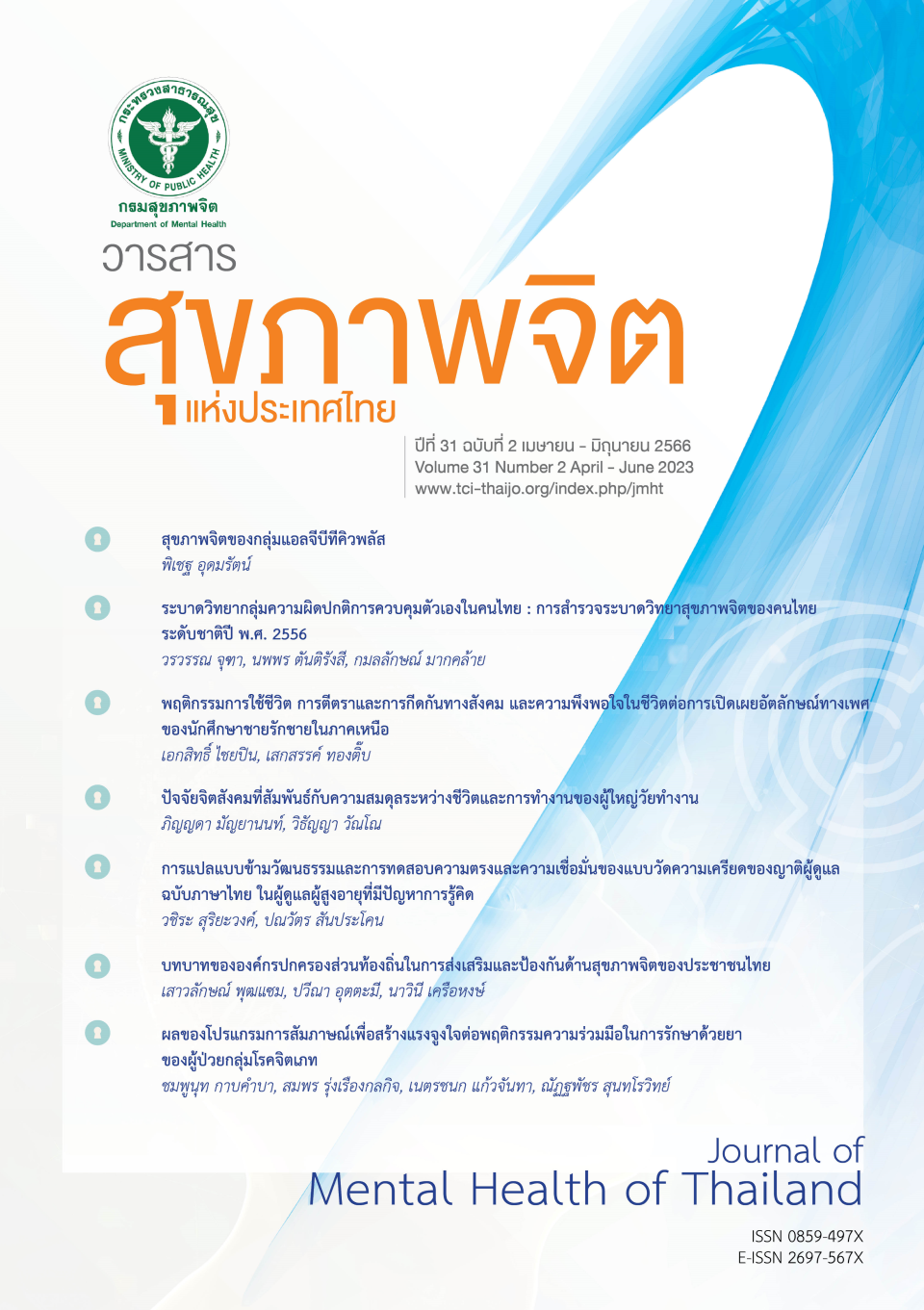การแปลแบบข้ามวัฒนธรรมและการทดสอบความตรงและความเชื่อมั่นของแบบวัดความเครียดของญาติผู้ดูแล ฉบับภาษาไทย ในผู้ดูแลผู้สูงอายุที่มีปัญหาการรู้คิด
คำสำคัญ:
การวิเคราะห์องค์ประกอบ, ความเชื่อมั่น, ความตรง, แบบวัดความเครียด, ปัญหาการรู้คิด, ผู้ดูแลบทคัดย่อ
วัตถุประสงค์ : เพื่อแปลและทดสอบความตรงและความเชื่อมั่นของแบบวัดความเครียดของญาติผู้ดูแลผู้สูงอายุที่มีปัญหาการรู้คิด
วิธีการ : แปลแบบวัดความเครียดของญาติผู้ดูแลจากภาษาอังกฤษเป็นภาษาไทยโดยผู้เชี่ยวชาญด้านการแปลภาษา 2 คน อย่างเป็นอิสระต่อกัน ตรวจสอบความเหมาะสมของภาษาโดยการแปลย้อนกลับเป็นภาษาต้นฉบับ ประเมินความตรงเชิงเนื้อหาโดยผู้เชี่ยวชาญ 5 คน จากนั้นศึกษาภาคตัดขวางเพื่อทดสอบคุณสมบัติของแบบวัดในผู้ดูแลผู้สูงอายุที่มีปัญหาการรู้คิด 100 คน ในชุมชนจังหวัดสุพรรณบุรี ประเมิน 2 ครั้ง ห่างกัน 2 สัปดาห์ ตรวจสอบความตรงเชิงโครงสร้างด้วยการวิเคราะห์องค์ประกอบเชิงสำรวจจากข้อมูลครั้งที่ 1 และการวิเคราะห์องค์ประกอบเชิงยืนยันจากข้อมูลครั้งที่ 2 วิเคราะห์ความเชื่อมั่นภายนอกระหว่างการทดสอบ 2 ครั้งด้วยสัมประสิทธิ์สหสัมพันธ์ภายในชั้น และวิเคราะห์ความเชื่อมั่นภายในด้วยสัมประสิทธิ์แอลฟาของครอนบาค
ผล : แบบวัดความเครียดของญาติผู้ดูแล ฉบับภาษาไทย จำนวน 15 ข้อ จำแนกเป็น 3 องค์ประกอบ ได้แก่ 1) ความกดดันส่วนบุคคล (personal distress) 2) ความปั่นป่วนวุ่นวายของชีวิต (degree of life upset) และ 3) ความรู้สึกเชิงลบต่อผู้สูงอายุ (negative feelings toward care recipient) มีค่าดัชนีความตรงเชิงเนื้อหา 0.92 และมีความสอดคล้องกันระหว่างตัวแปรสังเกตกับแต่ละองค์ประกอบ (χ2/df =1.70, RMSEA = 0.08, CFI = 0.93, TLI = 0.91) ค่าสัมประสิทธิ์สหสัมพันธ์ภายในชั้นของแต่ละองค์ประกอบอยู่ระหว่าง 0.96 - 0.98 และค่าสัมประสิทธิ์แอลฟาของครอนบาคของแต่ละองค์ประกอบอยู่ระหว่าง 0.89 - 0.91
สรุป : แบบวัดความเครียดของญาติผู้ดูแล ฉบับภาษาไทย มีความตรงและความเชื่อมั่นในระดับที่ดี เหมาะสำหรับใช้วัดความเครียดของผู้ดูแลที่ให้การดูแลผู้สูงอายุที่มีปัญหาด้านการรู้คิด
Downloads
เอกสารอ้างอิง
World Health Organization. Global status report on the public health response to dementia. Geneva: World Health Organization; 2021.
Deardorff WJ, Grossberg GT. Behavioral and psychological symptoms in Alzheimer's dementia and vascular dementia. Handb Clin Neurol. 2019;165:5-32. doi:10.1016/B978-0-444-64012-3.00002-2.
Llanque S, Savage L, Rosenburg N, Caserta M. Concept analysis: Alzheimer’s caregiver stress. Nurs Forum. 2016;51(1):21-31. doi:10.1111/nuf.12090.
Pearlin LI, Mullan JT, Semple SJ, Skaff MM. Caregiving and the stress process: an overview of concepts and their measures. Gerontologist. 1990;30(5):583-94. doi:10.1093/geront/30.5.583.
Wang H, Cui H, Wang M, Yang C. What you believe can affect how you feel: anger among caregivers of elderly people with dementia. Front Psychiatry. 2021;12:633730. doi:10.3389/fpsyt.2021.633730.
Robinson BC. Validation of a caregiver strain index. J Gerontol. 1983;38(3):344-8. doi:10.1093/geronj/38.3.344.
Caserta MS, Lund DA, Wright SD. Exploring the caregiver burden inventory (CBI): further evidence for a multidimensional view of burden. Int J Aging Hum Dev. 1996;43(1):21-34. doi:10.2190/2DKF-292P-A53W-W0A8.
Elmståhl S, Malmberg B, Annerstedt L. Caregiver's burden of patients 3 years after stroke assessed by a novel caregiver burden scale. Arch Phys Med Rehabil. 1996;77(2):177-82. doi:10.1016/s0003-9993(96)90164-1.
Zarit SH, Reever KE, Bach-Peterson J. Relatives of the impaired elderly: correlates of feelings of burden. Gerontologist. 1980;20(6):649-55. doi:10.1093/geront/20.6.649.
Cummings JL, Mega M, Gray K, Rosenberg-Thompson S, Carusi DA, Gornbein J. The neuropsychiatric inventory: comprehensive assessment of psychopathology in dementia. Neurology. 1994;44(12):2308-14. doi:10.1212/wnl.44.12.2308.
Peipert JD, Jennings LA, Hays RD, Wenger NS, Keeler E, Reuben DB. A composite measure of caregiver burden in dementia: the dementia burden scale-caregiver. J Am Geriatr Soc. 2018;66(9):1785-9. doi:10.1111/jgs.15502.
Novak M, Guest C. Application of a multidimensional caregiver burden inventory. Gerontologist. 1989;29(6):798-803. doi:10.1093/geront/29.6.798.
อรวรรณ ศิลปกิจ, ชัชวาลย์ ศิลปกิจ, รสสุคนธ์ ชมชื่น. คุณสมบัติทางจิตวิทยาของแบบประเมินภาระการดูแล Zarit ในผู้ป่วยจิตเวช [Psychometric study of the Thai version of Zarit burden interview in psychiatric caregivers]. วารสารสุขภาพจิตแห่งประเทศไทย. 2558;23(1):12-24.
Wongpakaran N, Wongpakaran T. Development of burden scale using rasch analysis. Int Psychogeriatr. 2019;31(S1):110.
พาวุฒิ เมฆวิชัย, สุรินทร์ แซ่ตัง. ผลกระทบจากการดูแลผู้ป่วยภาวะสมองเสื่อมในประเทศไทย [Caregiver burden among Thai dementia patients’ caregivers]. วารสารสมาคมจิตแพทย์แห่งประเทศไทย. 2556;58(1):101-10.
Senanarong V, Jamjumras P, Harmphadungkit K, Klubwongs M, Udomphanthurak S, Poungvarin N, et al. A counseling intervention for caregivers: effect on neuropsychiatric symptoms. Int J Geriatr Psychiatry. 2004;19(8):781-8. doi:10.1002/gps.1123.
Greene JG, Smith R, Gardiner M, Timbury GC. Measuring behavioural disturbance of elderly demented patients in the community and its effects on relatives: a factor analytic study. Age Ageing. 1982;11(2):121-6. doi:10.1093/ageing/11.2.121.
Ulstein I, Bruun Wyller T, Engedal K. The relative stress scale, a useful instrument to identify various aspects of carer burden in dementia? Int J Geriatr Psychiatry. 2007;22(1):61-7. doi:10.1002/gps.1654.
Luppa M, Riedel-Heller SG. Carers' distress. Int Psychogeriatr. 2021;33(4):311-3. doi:10.1017/S1041610220001192.
Tokovska M, Šolcová J. The burden of next-of-kin carers of dementia sufferers in the home environment. Healthcare (Basel). 2022;10(12):2441. doi:10.3390/healthcare10122441.
Sanprakhon P, Chaimongkol N, Hengudomsub P. Relationships between caregiving stress and sleep quality among family caregivers of older adults with dementia in Thailand. Belitung Nurs J. 2022;8(3):229-34. doi:10.33546/bnj.2106.
World Health Organization. Process of translation and adaptation of instruments [Internet]. Geneva; World Health Organization; 2016 [cited 2023 May 2]. Available from: https://terrance.who.int/mediacentre/data/WHODAS/Guidelines/WHODAS%202.0%20Translation%20guidelines.pdf.
Jones PS, Lee JW, Phillips LR, Zhang XE, Jaceldo KB. An adaptation of Brislin's translation model for cross-cultural research. Nurs Res. 2001;50(5):300-4. doi:10.1097/00006199-200109000-00008.
Rovinelli RJ, Hambleton RK. On the use of content specialists in the assessment of criterion-referenced test item validity. Dutch J Educ Res. 1977;2:49-60.
Nasreddine ZS, Phillips NA, Bédirian V, Charbonneau S, Whitehead V, Collin I, et al. The Montreal cognitive assessment, MoCA: a brief screening tool for mild cognitive impairment. J Am Geriatr Soc. 2005;53(4):695-9. doi:10.1111/j.1532-5415.2005.53221.x.
Reynolds GO, Manning L, Kirn D, Klein H, Hampton O, Burke O Jr, et al. Subjective cognitive decline in a registry sample: relation to psychiatric history, loneliness, and personality. J Prev Alzheimers Dis. 2022;9(3):435-40. doi:10.14283/jpad.2022.31.
Gorsuch RL. Factor analysis. 2nd ed. New Jersey: Erlbaum; 1983.
Gunawan J, Marzilli C, Aungsuroch Y. Establishing appropriate sample size for developing and validating a questionnaire in nursing research. Belitung Nurs J. 2021;7(5):356-60. doi:10.33546/bnj.1927.
Raykov T, Marcoulides GA. Introduction to psychometric theory. New York: Routledge, Taylor & Francis Group; 2011.
Koo TK, Li MY. A guideline of selecting and reporting intraclass correlation coefficients for reliability research. J Chiropr Med. 2016;15(2):155-63. doi:10.1016/j.jcm.2016.02.012.
Cronbach LJ. Coefficient alpha and the internal structure of tests. Psychometrika. 1951; 16(3):297-334. doi:10.1007/BF02310555.
Brown TA. Confirmatory factor analysis for applied research. New York: Guilford Press; 2006.
DiStefano C, Hess B. Using confirmatory factor analysis for construct validation: an empirical review. J Psychoeduc Assess. 2005;23(3):225-41. doi:10.1177/073428290502300303.
Howard MC. A review of exploratory factor analysis decisions and overview of current practices: what we are doing and how can we improve? Int J Hum-Comput Interact. 2016;32(1):51-62. doi:10.1080/10447318.2015.1087664.
Kline RB. Beyond significance testing: Reforming data analysis methods in behavioural research. Washington DC: American Psychological Association; 2000.
Hair JF, Black WC, Babin BJ, Anderson RE. Multivariate data analysis. 7th ed. Pearson Education International; 2010.
นันทพร ศรีนิ่ม. รายงานเบื้องต้น : ประสบการณ์ปัญหา และการเผชิญปัญหาของผู้ดูแลในการดูแลผู้ป่วยภาวะสมองเสื่อมที่บ้าน [Preliminary report: problems and coping experience of caregivers who provided care for dementia patients at home]. วารสารสุขภาพจิตแห่งประเทศไทย. 2558;23(1):61-71.
Shrout PE, Fleiss JL. Intraclass correlations: uses in assessing rater reliability. Psychol Bull. 1979;86(2):420-8. doi:10.1037//0033-2909.86.2.420.
ดาวน์โหลด
เผยแพร่แล้ว
รูปแบบการอ้างอิง
ฉบับ
ประเภทบทความ
สัญญาอนุญาต
ลิขสิทธิ์ (c) 2023 วารสารสุขภาพจิตแห่งประเทศไทย

อนุญาตภายใต้เงื่อนไข Creative Commons Attribution-NonCommercial-NoDerivatives 4.0 International License.
- ผู้อ่านสามารถนำข้อความ ข้อมูล จากวารสารไปใช้ไปใช้ประโยชน์ทางวิชาการได้ เช่น เพื่อการสอน เพื่อการอ้างอิง แต่การนำไปใช้เพื่อวัตถุประสงค์อื่น เช่น เพื่อการค้า จะต้องได้รับอนุญาตเป็นลายลักษณ์อักษรจากกรมสุขภาพจิตก่อน
- ความคิดเห็น ข้อมูล และบทสรุปต่าง ๆ ที่ลงตีพิมพ์ในวารสารสุขภาพจิตแห่งประเทศไทยเป็นของผู้เขียนบทความและมิได้แสดงว่ากองบรรณาธิการหรือกรมสุขภาพจิตเห็นพ้องด้วย




